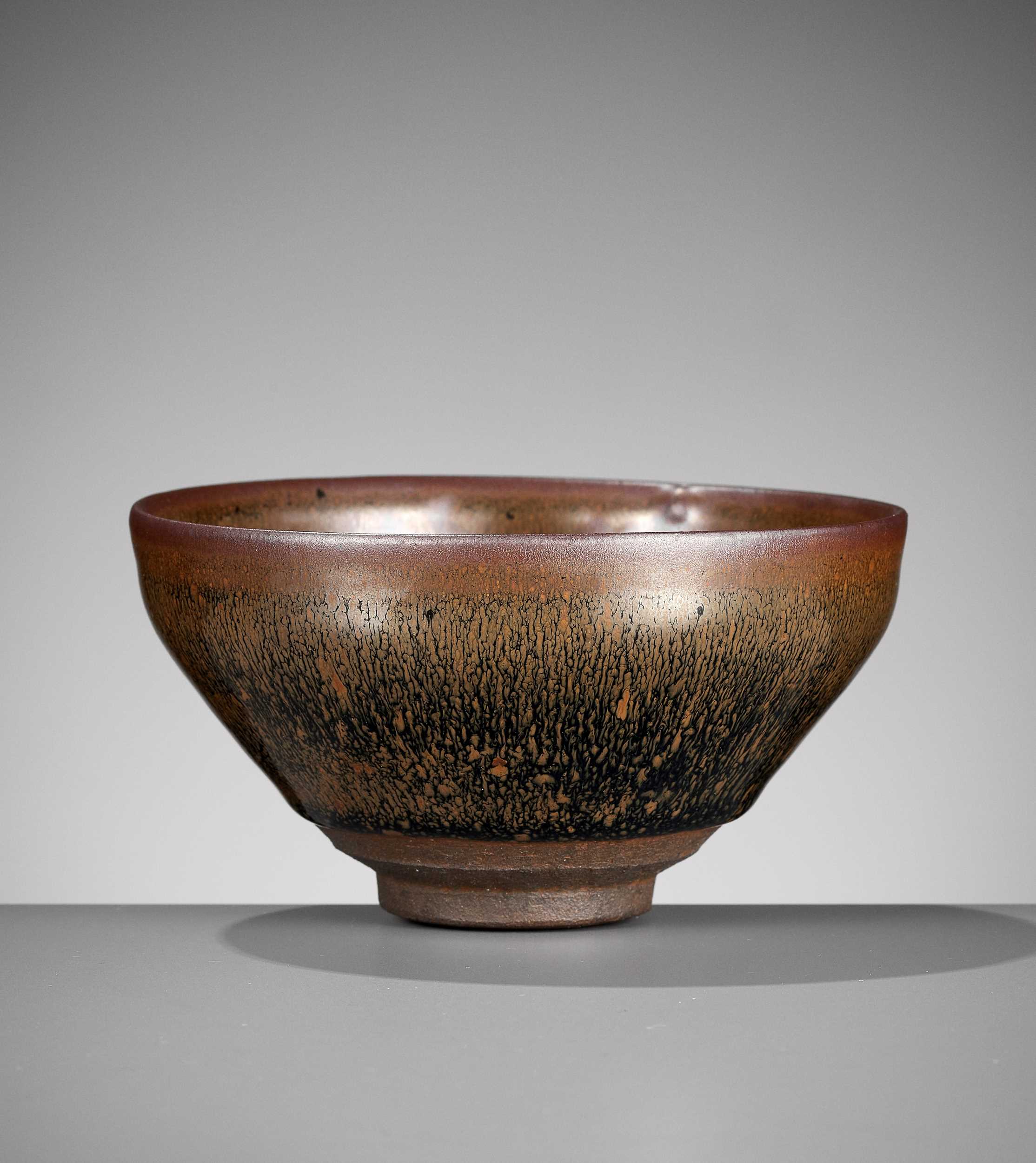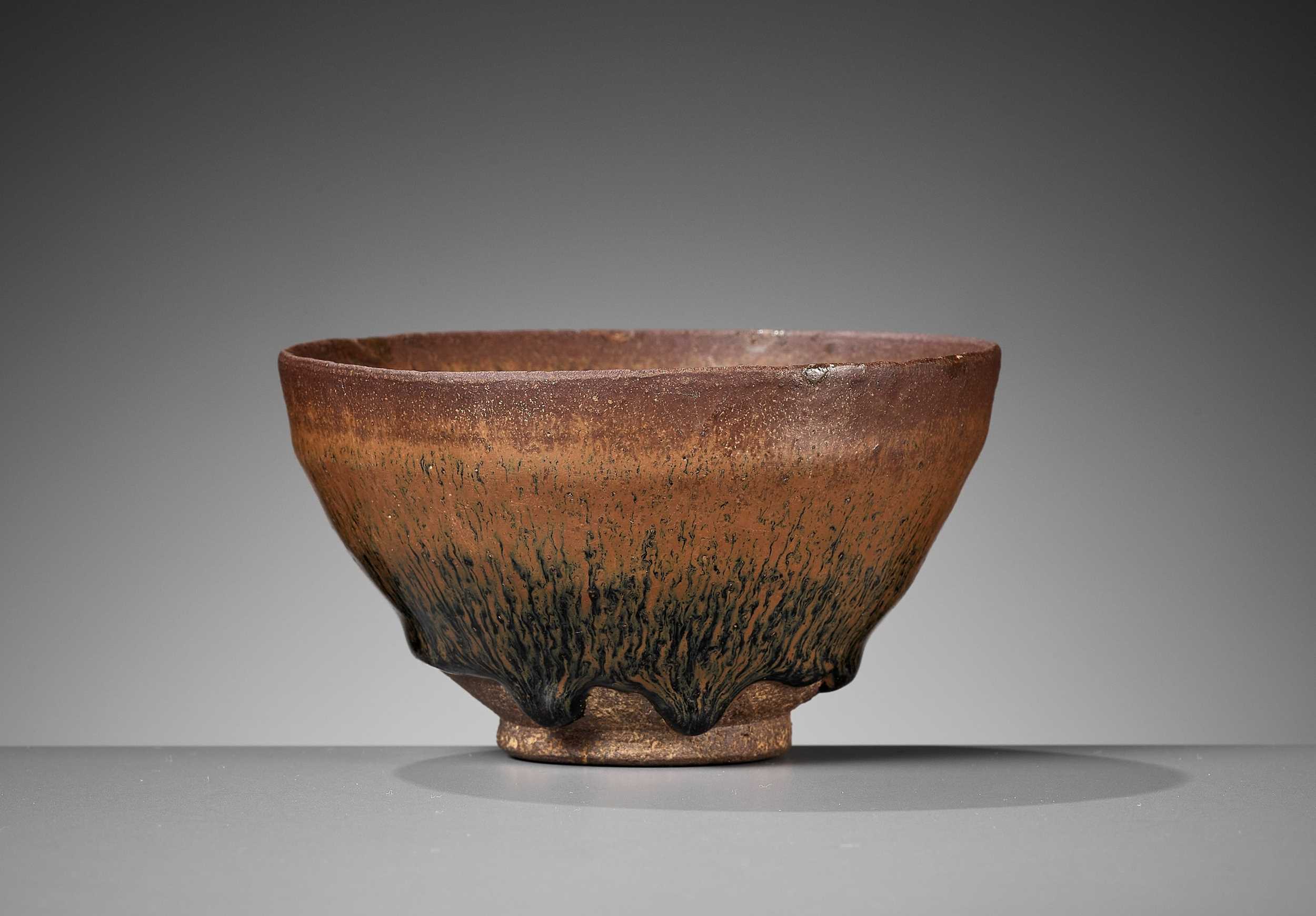A 'Jian' 'hare's fur' 'tenmoku' bowlSouthern Song dynasty南宋 建窰黑釉兔毫盞
metal-bound rim, Japanese wood box (3)
Diameter 4⅞ in., 12.3 cmCondition reportOverall in good condition with expected wear to foot.
Because this lot was imported into the United States after September 1, 2020, it is subject to an import tariff of 7.5% of the value declared upon entry into the United States. $4,500, plus applicable sales tax will be included on your invoice unless you instruct Sotheby's to arrange shipping of the lot to a foreign address. For more information on the import tariff, please review the Symbol Key in the back of the catalogue. If you have any questions, please contact tariffs@sothebys.com.
由於本拍品在2020年9月1日之後進口到美國,所以買家可能需就本拍品 支付進口關稅,金額為拍品進口美國當時申報價值的7.5%。除非您要求 蘇富比安排運送拍品到美國境外之地址,否則發票上將包括4,500美元以及 相關的銷售稅。如欲查詢進口關稅的更多信息,請查閱目錄背面的附 錄。 如有任何疑問,敬請聯繫tariffs@sothebys.com。
For more information on and additional videos for this lot, please contact serina.wei@sothebys.com.Catalogue noteThe humble appearance of tea bowls produced at the Jian kilns in Fujian province made them appropriate for use in Buddhist temples. Dramatically contrasting with the white foam of whipped tea, these lustrous black-glazed tea bowls soon gained popularity beyond monastic circles. The Song Emperor Huizong (r. 1101-1125), well known for his love for tea, stated that black-glazed tea bowls, especially those decorated with 'hare's fur' like the present example, were the most desirable. These bowls were likely already brought to Japan in the Kamakura period (1185-1333), when Japanese monks discovered the art of ritual tea preparation at Buddhist temples in southern China.
A similar bowl was included in the exhibition Karamono temmoku [Chinese temmoku], MOA Art Museum, Atami, 1994, cat. no. 6. This exhibition catalogue, where several important heirloom temmoku tea bowls preserved in Japan were juxtaposed with a large sample of excavated specimens from the kiln site, impressively documents the wide range of qualities and the excellence of the examples preserved in Japan. Another bowl with a similar glaze effect in the Metropolitan Museum of Art, New York, was included in the exhibition Hare's Fur, Tortoiseshell, and Partridge Feathers. Chinese Brown- and Black-Glazed Ceramics, 400-1400, Harvard University Art Museums, Cambridge, 1996, cat. no. 83. Other similar bowls include one preserved in the National Palace Museum, Taipei (accession no. 故-瓷-008624), and three other examples now in the Metropolitan Museum of Art, New York (accession nos 29.100.230, 29.100.227, 17.179.2),
A 'Jian' 'hare's fur' 'tenmoku' bowlSouthern Song dynasty南宋 建窰黑釉兔毫盞
metal-bound rim, Japanese wood box (3)
Diameter 4⅞ in., 12.3 cmCondition reportOverall in good condition with expected wear to foot.
Because this lot was imported into the United States after September 1, 2020, it is subject to an import tariff of 7.5% of the value declared upon entry into the United States. $4,500, plus applicable sales tax will be included on your invoice unless you instruct Sotheby's to arrange shipping of the lot to a foreign address. For more information on the import tariff, please review the Symbol Key in the back of the catalogue. If you have any questions, please contact tariffs@sothebys.com.
由於本拍品在2020年9月1日之後進口到美國,所以買家可能需就本拍品 支付進口關稅,金額為拍品進口美國當時申報價值的7.5%。除非您要求 蘇富比安排運送拍品到美國境外之地址,否則發票上將包括4,500美元以及 相關的銷售稅。如欲查詢進口關稅的更多信息,請查閱目錄背面的附 錄。 如有任何疑問,敬請聯繫tariffs@sothebys.com。
For more information on and additional videos for this lot, please contact serina.wei@sothebys.com.Catalogue noteThe humble appearance of tea bowls produced at the Jian kilns in Fujian province made them appropriate for use in Buddhist temples. Dramatically contrasting with the white foam of whipped tea, these lustrous black-glazed tea bowls soon gained popularity beyond monastic circles. The Song Emperor Huizong (r. 1101-1125), well known for his love for tea, stated that black-glazed tea bowls, especially those decorated with 'hare's fur' like the present example, were the most desirable. These bowls were likely already brought to Japan in the Kamakura period (1185-1333), when Japanese monks discovered the art of ritual tea preparation at Buddhist temples in southern China.
A similar bowl was included in the exhibition Karamono temmoku [Chinese temmoku], MOA Art Museum, Atami, 1994, cat. no. 6. This exhibition catalogue, where several important heirloom temmoku tea bowls preserved in Japan were juxtaposed with a large sample of excavated specimens from the kiln site, impressively documents the wide range of qualities and the excellence of the examples preserved in Japan. Another bowl with a similar glaze effect in the Metropolitan Museum of Art, New York, was included in the exhibition Hare's Fur, Tortoiseshell, and Partridge Feathers. Chinese Brown- and Black-Glazed Ceramics, 400-1400, Harvard University Art Museums, Cambridge, 1996, cat. no. 83. Other similar bowls include one preserved in the National Palace Museum, Taipei (accession no. 故-瓷-008624), and three other examples now in the Metropolitan Museum of Art, New York (accession nos 29.100.230, 29.100.227, 17.179.2),
.jpg)
.jpg)
.jpg)
.jpg)



.jpg)
.jpg)
.jpg)

.jpg)
.jpg)


Testen Sie LotSearch und seine Premium-Features 7 Tage - ohne Kosten!
Lassen Sie sich automatisch über neue Objekte in kommenden Auktionen benachrichtigen.
Suchauftrag anlegen